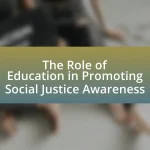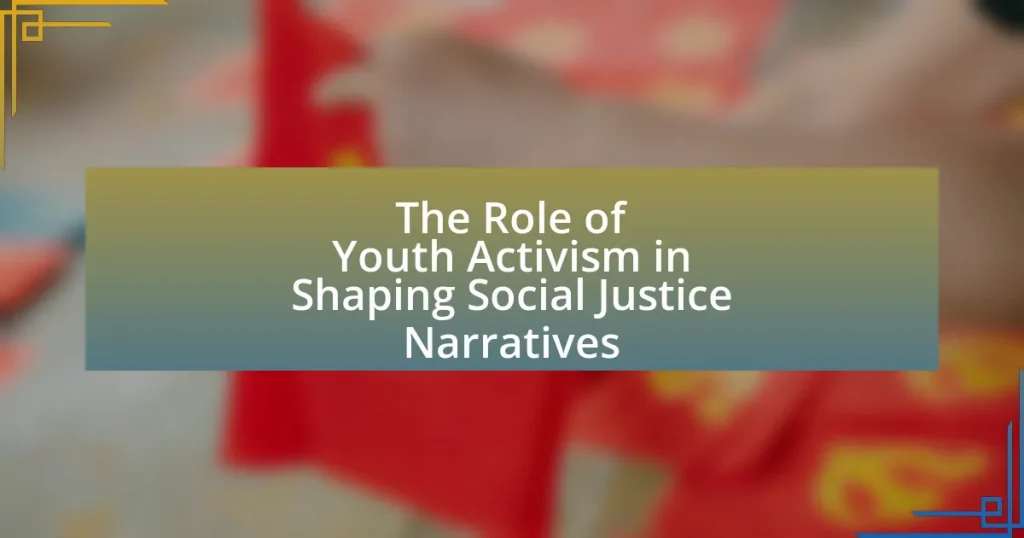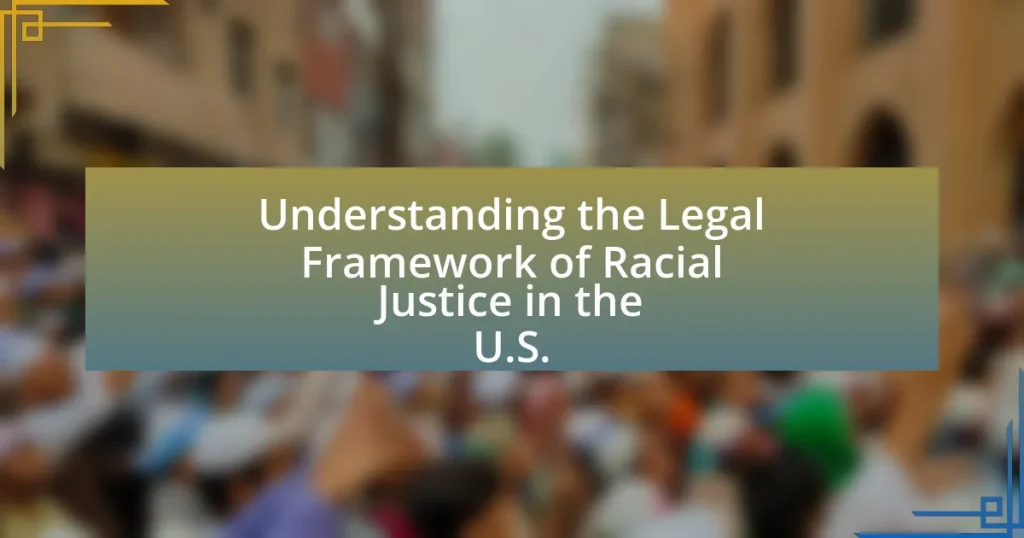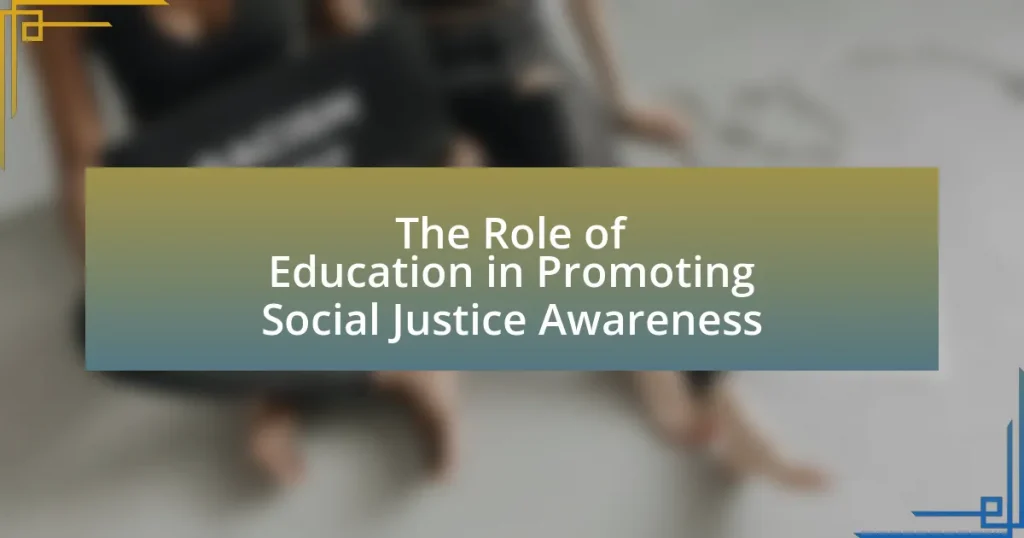Youth activism is a pivotal force in shaping social justice narratives by amplifying marginalized voices and driving systemic change. This article explores the historical influence of youth activism on social justice movements, highlighting key events such as the Civil Rights Movement and contemporary initiatives like Black Lives Matter and climate strikes. It examines the evolution of youth-led movements, the unique perspectives they bring, and the challenges they face, including societal perceptions and resource limitations. Additionally, the article discusses strategies for enhancing youth activism, the role of education, and the impact of emerging technologies on future activism trends.
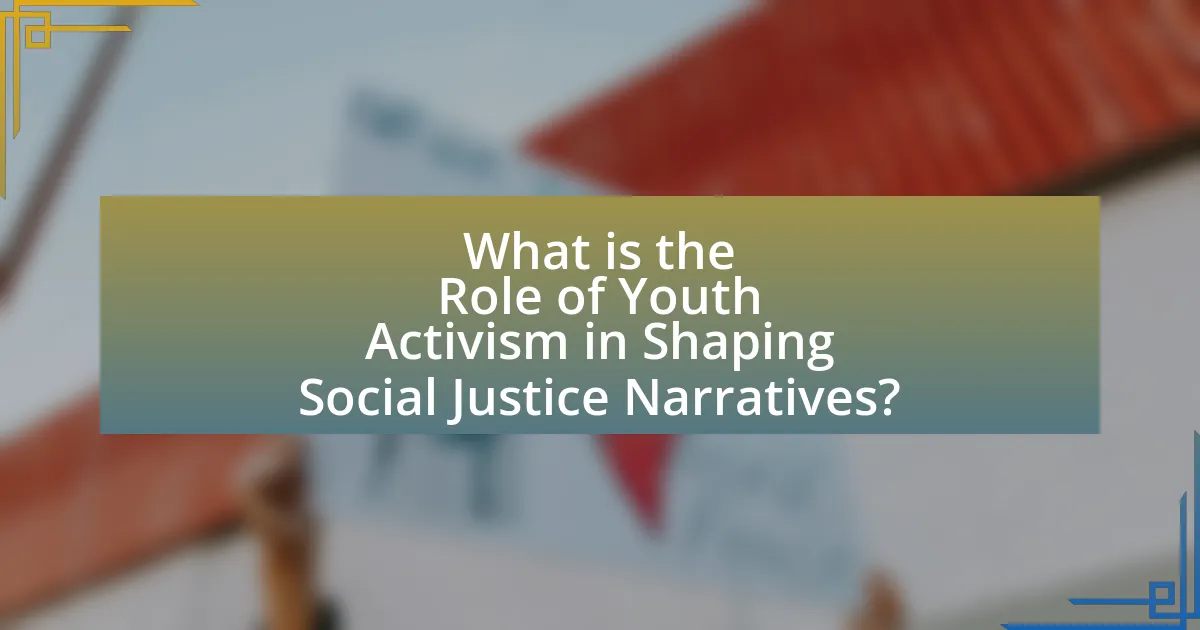
What is the Role of Youth Activism in Shaping Social Justice Narratives?
Youth activism plays a crucial role in shaping social justice narratives by amplifying marginalized voices and driving systemic change. Young activists utilize social media platforms to raise awareness about issues such as climate change, racial inequality, and gender rights, effectively mobilizing their peers and influencing public discourse. For instance, movements like Black Lives Matter and Fridays for Future have been largely driven by youth, demonstrating their capacity to challenge established narratives and advocate for policy reforms. Research indicates that youth-led initiatives often lead to increased civic engagement and can shift societal attitudes, as seen in the significant youth turnout during recent elections, which has been linked to heightened awareness of social justice issues.
How has youth activism historically influenced social justice movements?
Youth activism has historically played a crucial role in influencing social justice movements by mobilizing young people to advocate for change and challenge systemic injustices. For instance, during the Civil Rights Movement in the 1960s, youth-led organizations like the Student Nonviolent Coordinating Committee (SNCC) were instrumental in organizing protests, sit-ins, and voter registration drives, significantly advancing the cause of racial equality. Additionally, the anti-Vietnam War protests in the late 1960s saw young activists rallying against military involvement, which shifted public opinion and policy. These examples illustrate how youth activism has not only raised awareness but also directly impacted legislative changes and societal attitudes, demonstrating its enduring influence on social justice movements throughout history.
What key events highlight the impact of youth activism on social justice?
Key events that highlight the impact of youth activism on social justice include the March for Our Lives in 2018, which was organized by students from Stoneman Douglas High School following a mass shooting, advocating for gun control and influencing legislation. Another significant event is the global climate strikes initiated by Greta Thunberg in 2018, which mobilized millions of young people worldwide to demand action on climate change, leading to increased awareness and policy discussions. Additionally, the Black Lives Matter movement, particularly the protests in 2020 following the murder of George Floyd, saw substantial youth participation, driving conversations about racial justice and police reform. These events demonstrate how youth activism can effectively shape public discourse and influence policy changes in social justice issues.
How have youth-led movements evolved over time?
Youth-led movements have evolved from localized, grassroots initiatives to global, digitally connected campaigns. Initially, youth activism focused on specific issues within communities, such as civil rights and anti-war protests in the 1960s, exemplified by the Student Nonviolent Coordinating Committee in the United States. Over time, the advent of social media has transformed these movements, enabling rapid mobilization and broader outreach, as seen in the global climate strikes initiated by Greta Thunberg in 2018. This evolution reflects a shift towards intersectionality and inclusivity, with movements now addressing a range of social justice issues, including racial equality, gender rights, and environmental sustainability, demonstrating the increasing complexity and interconnectedness of youth activism.
Why is youth activism crucial for contemporary social justice narratives?
Youth activism is crucial for contemporary social justice narratives because it brings fresh perspectives and energy to movements advocating for change. Young activists often leverage social media to amplify their voices, mobilize peers, and raise awareness about pressing issues such as climate change, racial inequality, and gender rights. For instance, the global climate strikes initiated by Greta Thunberg in 2018 mobilized millions of young people worldwide, demonstrating the power of youth-led initiatives in shaping public discourse and policy. This engagement not only challenges existing power structures but also fosters intergenerational dialogue, ensuring that the concerns of younger generations are integrated into broader social justice frameworks.
What unique perspectives do young activists bring to social justice issues?
Young activists bring fresh, innovative perspectives to social justice issues by leveraging their unique experiences and understanding of contemporary challenges. Their familiarity with digital platforms allows them to mobilize quickly and effectively, reaching diverse audiences and fostering global solidarity. For instance, movements like Black Lives Matter and Fridays for Future have gained traction largely due to the strategic use of social media by young activists, demonstrating their ability to engage and inform the public on pressing issues. Additionally, young activists often prioritize intersectionality, recognizing how various forms of oppression intersect, which leads to more inclusive and comprehensive approaches to social justice. This perspective is supported by research from the Harvard Kennedy School, which highlights that youth-led movements are more likely to address multiple social issues simultaneously, reflecting the interconnected nature of societal challenges.
How does youth activism challenge traditional narratives in social justice?
Youth activism challenges traditional narratives in social justice by introducing innovative perspectives and demanding accountability from established institutions. This generational shift often emphasizes intersectionality, highlighting how various forms of oppression are interconnected, which contrasts with older, more singular approaches to social justice. For instance, movements like Black Lives Matter, initiated by young activists, have reframed discussions around race, police brutality, and systemic inequality, pushing for broader societal recognition of these issues. Additionally, youth-led initiatives often leverage social media to amplify their messages, reaching wider audiences and mobilizing support rapidly, which traditional narratives may not effectively utilize. This dynamic engagement not only reshapes public discourse but also pressures policymakers to address the concerns of younger generations, thereby redefining the landscape of social justice activism.
What are the primary methods used by youth activists to shape narratives?
Youth activists primarily shape narratives through social media campaigns, grassroots organizing, and storytelling. Social media campaigns allow them to reach a wide audience quickly, facilitating the dissemination of their messages and mobilizing support. Grassroots organizing involves building community coalitions and engaging in direct action, which helps to amplify their voices and influence public discourse. Storytelling serves as a powerful tool to humanize issues, making them relatable and compelling, thereby fostering empathy and understanding among diverse audiences. These methods have been effective in movements such as Black Lives Matter and climate activism, where youth have successfully shifted public narratives and policy discussions.
How do social media platforms amplify youth activism?
Social media platforms amplify youth activism by providing accessible channels for communication, organization, and mobilization. These platforms enable young activists to share their messages widely, connect with like-minded individuals, and coordinate events or campaigns efficiently. For instance, the #BlackLivesMatter movement gained significant traction through Twitter and Instagram, where youth shared personal stories, organized protests, and raised awareness about racial injustice. Research indicates that 70% of young people believe social media is an effective tool for activism, highlighting its role in shaping public discourse and influencing social justice narratives.
What role do grassroots organizing and community engagement play?
Grassroots organizing and community engagement are essential for mobilizing individuals and fostering collective action towards social justice. These approaches empower marginalized voices, enabling communities to identify their needs and advocate for change effectively. For instance, the Black Lives Matter movement, which began as a grassroots initiative, successfully raised awareness about systemic racism and police brutality, leading to widespread protests and policy discussions. Research by the Stanford Social Innovation Review highlights that grassroots movements can influence public policy by creating a strong narrative that resonates with the broader population, demonstrating the significant impact of community-driven efforts in shaping social justice narratives.
How does youth activism intersect with other social movements?
Youth activism intersects with other social movements by amplifying voices and driving change across various issues such as climate justice, racial equality, and gender rights. For instance, the youth-led climate strikes initiated by Greta Thunberg have not only highlighted environmental concerns but also connected with movements advocating for social justice, demonstrating how climate action is intertwined with economic and racial equity. Research indicates that young activists often collaborate with established movements, leveraging social media to mobilize support and raise awareness, as seen in the Black Lives Matter movement, where youth played a crucial role in organizing protests and spreading messages globally. This intersectionality enhances the effectiveness of both youth activism and broader social movements, creating a unified front for systemic change.
What connections exist between youth activism and climate justice?
Youth activism is intrinsically connected to climate justice as it mobilizes young people to advocate for equitable solutions to climate change impacts. This connection is evident in movements like Fridays for Future, initiated by Greta Thunberg, which emphasizes the need for immediate action to address climate issues that disproportionately affect marginalized communities. Research shows that youth-led initiatives often highlight the intersectionality of social justice and environmental sustainability, advocating for policies that not only combat climate change but also address systemic inequalities. For instance, the 2021 UN Climate Change Conference saw significant youth participation, underscoring their role in pushing for climate policies that prioritize justice and equity.
How does youth activism relate to racial and gender equality movements?
Youth activism is intrinsically linked to racial and gender equality movements as it amplifies marginalized voices and drives social change. Young activists often mobilize around issues of systemic racism and gender discrimination, utilizing platforms like social media to raise awareness and advocate for policy reforms. For instance, movements such as Black Lives Matter, which gained significant traction among youth, highlight the intersectionality of race and gender, addressing how these identities experience oppression differently. Additionally, studies show that youth-led initiatives, such as the March for Our Lives, not only focus on gun control but also emphasize the importance of racial and gender equity, demonstrating a holistic approach to social justice. This interconnectedness illustrates how youth activism serves as a catalyst for broader societal shifts towards equality.
What challenges do youth activists face in shaping social justice narratives?
Youth activists face significant challenges in shaping social justice narratives, primarily due to systemic barriers, lack of resources, and generational biases. Systemic barriers include institutional resistance from established organizations that may not prioritize youth perspectives, limiting their influence. Additionally, youth activists often lack access to funding and platforms necessary for amplifying their messages, which hinders their ability to reach broader audiences. Generational biases also play a role, as older generations may dismiss youth voices as inexperienced or radical, undermining their credibility in discussions about social justice. These challenges collectively impede the effectiveness of youth activism in driving meaningful change in social justice narratives.
How do societal perceptions of youth impact their activism?
Societal perceptions of youth significantly influence their activism by shaping the legitimacy and visibility of their voices. When society views young people as capable and informed, it encourages their participation in social movements, as seen in the global climate strikes led by youth activists like Greta Thunberg, which garnered widespread media attention and support. Conversely, negative perceptions, such as viewing youth as inexperienced or apathetic, can undermine their efforts and limit their engagement in activism. Research indicates that youth-led movements often face skepticism from older generations, which can hinder their ability to effect change. For instance, a study by the Pew Research Center found that while younger individuals are more likely to engage in activism, they often encounter barriers due to age-related biases. Thus, societal perceptions play a crucial role in either empowering or constraining youth activism.
What barriers do young activists encounter in mobilizing support?
Young activists encounter several barriers in mobilizing support, including lack of resources, limited access to networks, and generational divides. These obstacles hinder their ability to effectively organize and gain traction for their causes. For instance, many young activists lack financial backing, which restricts their capacity to host events or campaigns. Additionally, they often struggle to connect with established organizations that could provide mentorship or logistical support, as these networks may be dominated by older generations who may not fully understand or prioritize youth-led initiatives. Furthermore, societal perceptions of youth activism can lead to dismissive attitudes, undermining the credibility of young activists and their movements.
What strategies can enhance the effectiveness of youth activism?
To enhance the effectiveness of youth activism, strategies such as leveraging social media, building coalitions, and engaging in grassroots organizing are essential. Social media platforms enable youth activists to reach a broader audience quickly, facilitating the dissemination of information and mobilization efforts. For instance, the #BlackLivesMatter movement utilized Twitter to amplify its message, resulting in widespread global protests and discussions about racial justice.
Building coalitions with established organizations can provide youth activists with resources, mentorship, and credibility, thereby increasing their impact. Collaborations, such as those seen during the March for Our Lives campaign, demonstrate how youth can unite with various stakeholders to advocate for gun reform effectively.
Additionally, grassroots organizing fosters community involvement and empowers local voices, which is crucial for sustainable change. Research shows that grassroots movements, like the Sunrise Movement for climate action, have successfully influenced policy discussions by mobilizing community members and creating a sense of urgency around their causes. These strategies collectively enhance the effectiveness of youth activism by increasing visibility, fostering collaboration, and empowering communities.
How can collaboration with established organizations benefit youth activists?
Collaboration with established organizations can significantly benefit youth activists by providing access to resources, networks, and expertise that enhance their impact. Established organizations often have established credibility, which can amplify the voices of youth activists and lend legitimacy to their causes. For instance, partnerships can lead to increased funding opportunities; according to a report by the National Youth Leadership Council, youth-led initiatives that partnered with established nonprofits received 40% more funding than those that did not. Additionally, collaboration allows youth activists to learn from experienced mentors, gaining valuable skills in advocacy, organization, and strategic planning, which are crucial for effective activism.
What role does education play in empowering young activists?
Education plays a crucial role in empowering young activists by equipping them with the knowledge and skills necessary to advocate for social change. Through education, young individuals gain awareness of social issues, understand their rights, and learn effective strategies for mobilization and advocacy. For instance, studies show that youth who participate in educational programs focused on civic engagement are more likely to become involved in activism, as they develop critical thinking skills and a sense of agency. Additionally, educational institutions often provide platforms for young activists to collaborate, share ideas, and amplify their voices, further enhancing their impact on social justice narratives.
What are the future prospects for youth activism in social justice?
The future prospects for youth activism in social justice are highly promising, driven by increased digital engagement and a growing awareness of social issues among young people. Research indicates that 70% of youth believe they can influence social change, as evidenced by movements like Black Lives Matter and climate activism, which have mobilized millions globally. Furthermore, the rise of social media platforms has enabled youth to organize, share information, and amplify their voices more effectively than ever before, leading to significant policy changes and societal shifts. This trend is supported by studies showing that youth-led initiatives are more likely to engage diverse communities and foster inclusive dialogues, thereby enhancing their impact on social justice narratives.
How might emerging technologies influence youth activism?
Emerging technologies significantly influence youth activism by enhancing communication, mobilization, and awareness. Social media platforms, for instance, allow young activists to share their messages widely and rapidly, reaching global audiences. According to a 2020 Pew Research Center study, 72% of teens use social media, which facilitates the organization of events and campaigns, such as climate strikes and social justice movements. Additionally, technologies like mobile apps and online petitions streamline the process of gathering support and resources, enabling youth to engage more effectively in activism. The use of data analytics also empowers young activists to tailor their strategies based on real-time feedback and trends, increasing the impact of their efforts.
What trends are shaping the next generation of youth activists?
The next generation of youth activists is being shaped by trends such as digital engagement, intersectionality, and climate justice. Digital engagement allows activists to leverage social media platforms for organizing, mobilizing, and raising awareness, as seen in movements like Black Lives Matter and Fridays for Future. Intersectionality emphasizes the interconnectedness of various social issues, encouraging youth to advocate for a broader range of causes, including racial, gender, and economic justice. Climate justice has emerged as a central focus, with young activists leading the charge against climate change, exemplified by the global climate strikes initiated by Greta Thunberg. These trends reflect a shift towards more inclusive, interconnected, and technology-driven activism among youth.
What practical steps can young people take to engage in social justice activism?
Young people can engage in social justice activism by educating themselves about social issues and participating in community initiatives. By researching topics such as racial inequality, climate change, or gender rights, they can develop informed perspectives that contribute to meaningful discussions. Participation in local organizations or volunteer programs allows youth to take direct action, fostering community engagement and collaboration. Additionally, utilizing social media platforms to raise awareness and mobilize peers can amplify their voices and reach a broader audience. Studies show that youth-led movements, such as the March for Our Lives, have significantly influenced public policy and awareness, demonstrating the impact of young activists in shaping social justice narratives.

